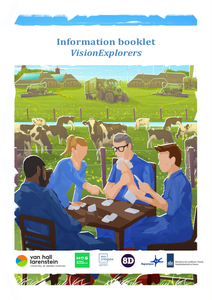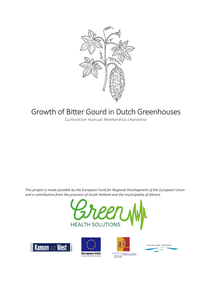At the department of electrical and electronic engineering of Fontys University of Applied Sciences we are defining a real-life learning context for our students, where the crossover with regional healthcare companies and institutes is maximized. Our innovative educational step is based on openly sharing electronic designs for health related measurement modalities as developed by our students. Because we develop relevant reference designs, the cross fertilization with society is large and so the learning cycle is short.
DOCUMENT

The 'AgroCycle' project investigates whether a cooperation of farms can become self-sufficient in energy and fertilization by using manure and organic waste streams for the production of energy, green fuel and green fertilizers by means of anaerobic digestion (AD). In the project, the project partners aim to link the nutrient cycle (from manure to digestate to green fertilizer) to a self-sufficient energy system (biomass to biogas to green fuel for processing the land) through the combined production of biogas and green fertilizers. The financial feasibility of a bio-digester is highly dependent on the use and economic value of the digestate. This combined approach increases both feasibility and sustainability (environmental impacts and CO2 emissions). To explore the feasibility of the aforementioned concept, use is made of the existing 'BioGas simulator' model developed by Hanze UAS to simulate the technical process of decentralized production of biogas and the economic cost.
DOCUMENT

Renewing agricultural grasslands for improved yields and forage quality generally involves eliminating standing vegetation with herbicides, ploughing and reseeding. However, grassland renewal may negatively affect soil quality and related ecosystem services. On clay soil in the north of the Netherlands, we measured grass productivity and soil chemical parameters of ‘young’ (5–15 years since last grassland renewal) and ‘old’ (>20 years since last grassland renewal) permanent grasslands, located as pairs at 10 different dairy farms. We found no significant difference with old permanent grassland in herbage dry matter yield and fertilizer nitrogen (N) response, whereas herbage N yield was lower in young permanent grassland. Moreover, the young grassland soil contained less soil organic matter (SOM), soil organic carbon (C) and soil organic N compared to the old grassland soil. Grass productivity was positively correlated with SOM and related parameters such as soil organic C, soil organic N and potentially mineralizable N. We conclude that on clay soils with 70% desirable grasses (i.e., Lolium perenne and Phleum pratense) or more, the presumed yield benefit of grassland renewal is offset by a loss of soil quality (SOM and N-total). The current practice of renewing grassland after 10 years without considering the botanical composition, is counter-productive and not sustainable.
DOCUMENT

LINK
The biomass demand for the use as both renewable energy source and raw material for the biotechnology industry is increasing. Simultaneously, the supply of biomass is requested to become more costcompetitive. Innovative solutions for cost-effective biomass production should also avoid indirect land use changes and direct negative environmental effects. The main aim of this study is to identify the most promising innovative lignocellulosic cropping systems regarding environmental sustainability as well as social acceptance for different cost scenarios and different regions in Europe. To gather innovative cropping knowledge from around Europe ADVANCEFUEL organized a workshop. Participating Horizon 2020 projects presenting innovative approaches onlignocellulosic cropping systems included: FORBIO, MAGIC, BECOOL, LIBBIO, GRACE, and SEEMLA. Data was collected from field studies of the participating projects prior to the workshop and later presented in an aggregated way as a basis for discussions. This approach incorporates the knowledge gained in over 60 study cases conducted in 12 different countries. Under these study cases, 16 different lignocellulosic crops were covered. This field based knowledge can be used to validate spatial assessments of sustainable biomass production potentials in Europe.
DOCUMENT

Managing dairy excreta as slurry can result in significant emissions of ammonia (NH3) and greenhouse gases (GHGs) during storage and thereafter. Additionally, slurry often has an imbalanced nitrogen (N) to phosphorus (P) ratio for crop fertilization. While various treatments exist to address emissions and nutrient imbalances, each has trade-offs that can result in pollution swapping. An integrated management system, starting with source segregation (SS) in-house to separate faeces and urine into two manageable streams followed by step-wise complementary treatments has been designed to manage nutrients and reduce emissions in the whole chain, but its effect on emissions in storage remains untested. This study investigated NH3, nitrous oxide (N2O), and methane (CH4) emissions and total N losses from integrated storage systems combining SS, mesophilic or thermophilic anaerobic digestion (AD), acidification, drying and zeolite addition and an impermeable cover. These systems were compared to two reference slurry storage systems: in-house uncovered (US) and outside covered (CS). A 30-day lab-scale experiment was conducted at 10 °C, monitoring emissions using an INNOVA1412 gas analyser, while total N losses were assessed using mass balance. Results indicated that the SS fractions treated before covered storage exhibited significantly lower emissions (NH3 or CH4 or both) compared to both reference slurry storage systems (US and CS). Source segregation combined with acidification of urine and AD of faeces at 35 °C and an impermeable cover allowed for a 99% reduction in NH3 emissions, a 45% reduction in CH4 emissions and had no effect on N2O emissions as compared to US. When AD of faeces was conducted at 55 °C instead of 35 °C, the CH4 emission was reduced by 77% compared to US. This study concludes that SS combined with urine and faeces treatment allows a more effective and simultaneous reduction of all emissions in storage as compared to slurry storage systems, while also effectively separating nutrients allowing more precise N and P fertilization with dairy excreta. Further research is necessary to assess emissions and fertilizer value of treated fractions after field application, in addition to the associated costs.
LINK
This guide is a useful tool for the VisionExplorers game. The guide explains different farm visions, success factors and measures. The guide also helps you to find measures that fit well with your company vision. In short, this guide provides additional explanation during and after playing the game.
DOCUMENT

This guide is a useful tool for the VisionExplorers game. The guide explains different farm visions, success factors and measures. The guide also helps you to find measures that fit well with your company vision. In short, this guide provides additional explanation during and after playing the game.
DOCUMENT

Bitter gourd is also called sopropo, balsam-pear, karela or bitter melon and is a member of the cucumber family (Cucurbitaceae). It is a monoecious, annual, fast-growing and herbaceous creeping plant. The wrinkled fruit of the bitter gourd is consumed as a vegetable and medicine in Asia, East Africa, South America and India. The aim of this bitter gourd cultivation manual is to make this cultivation accessible to Dutch growers and in this way be able to meet market demand. In addition, this cultivation manual aims to provide insight into the standardized production of the medicinal ingredients in the fruit.
DOCUMENT

n the work package described in this report, members are investigating whether a cooperative of farmers can become self-sufficient in energy and fertilization by using manure and organic waste flows in combination with anaerobic fermentation. The aim is to link the nutrient cycle (from manure to digestate to green fertilizer consisting of, for example, nitrate, phosphate, potassium, and trace elements) to a self-sufficient energy system, by the combined production of electricity, green gas, green fuels, and green fertilizers. Within this research such a system is called a circular multi commodity system (CMCS). In effect linking, the nutrient cycle with an energy production chain. In addition, other energy sources and sinks can also play a role in the system such as wind, solar PV and storage (e.g. batteries or hydrogen). For this symbiosis of production techniques to succeed in practice, intensive cooperation between arable farmers and dairy farmers is needed. Farmers supply part of the input from the biofermenter and receive green fertilizers at the end of the process, which are used as a substitute for fertilizer. The case is based on a cooperative of farmers with a minimal geographical spread and maximum diversity in type of business. In this way, the current waste and nutrient chain is being replaced by a more sustainable and closed cycle. This could provide significant environmental benefits: reduction of the environmental impact through the use of fertilizer, reduction of dependence on fossil raw materials, and reduction of CO2 emissions.
DOCUMENT